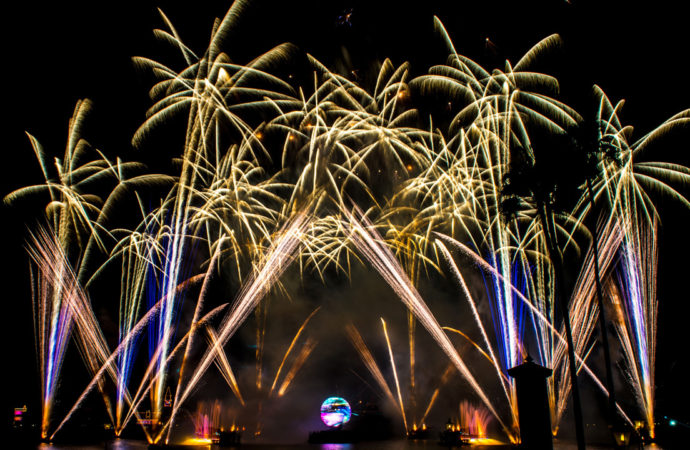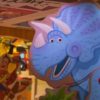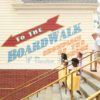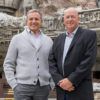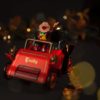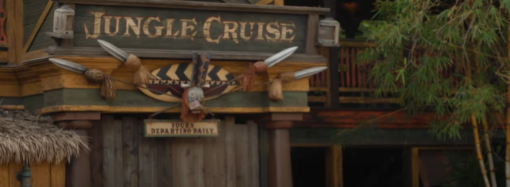NOTE: This story originally appeared on 1 May 2011 on The Dis. This edited story is reprinted with permission from the author.
This year will mark a number of changes at EPCOT. Although more were to come to fruition, the novel coronavirus pandemic sidelined many of those plans. They will probably happen, but just not now. One of those new projects happening this year is “HarmonioUS.” Although the new show was scheduled to debut last year, the pandemic put a pause on all construction for a few months.

“HarmonioUS,” which is replacing one of Disney’s longest running nighttime show – “IllumiNations: Reflections of Earth,” is described as a celebration of “how the music of Disney inspires people the world over” and will feature “massive floating set pieces, custom-built LED panels, choreographed moving fountains, lights, pyrotechnics, lasers and more.” “HarmonioUS” was expected to open sometime in 2020, but work was temporary halted with the closure of the park. The show will now make its debut later in 2021.
Many fans have high hopes for the new show considering it is replacing one of the most popular shows at the theme park.
Looking back at “IllumiNations: Reflections of Earth”
Every year, millions of people visit the Walt Disney World Resort. For those who have been there before, reliving experiences and memories of restaurants, attractions, and shows are just as important (and sometimes more important) as creating new memories. One of those experiences is seeing Epcot’s current lagoon spectacular … IllumiNations: Reflections of Earth.
For those who have never seen the show or for those who saw it a while ago, the show is an emotional journey through the past, present, and future. It is told through: An Introduction, Act I: Chaos, Act II: Order, Act III: Meaning, and a Post Show.
THE INTRODUCTION

“Good evening. On behalf of Walt Disney World, the place where dreams come true, we welcome all of you to Epcot and World Showcase. We’ve gathered here tonight, around the fire, as people of all lands have gathered for thousands and thousands of years before us; to share the light and to share a story. An amazing story, as old as time itself, but still being written. And though each of us has our own individual stories to tell, a true adventure emerges when we bring them all together as one. We hope you enjoy our story tonight; Reflections of Earth.”
Right after the announcement, the announcer “blows” out the torches and the lighting around the lagoon. Lighting on Spaceship Earth is reduced and then…Illuminations begins.
ACT 1: CHAOS
The show starts off with a slow drumbeat in the darkness. The drums pound faster until a screech is heard as a lone firework races up and arcs towards the middle of the lagoon only to explode and start the chaos that is the creation of the universe and eventually the Earth. There are explosions, eruptions, spewing fire and spouting water. This act is told through lasers, fireworks, and the Inferno Barge.

ACT II – ORDER
As the final burst of fireworks finishes overhead, The Earth Globe appears. Since its LED screens are off for the first two minutes and the Globe is brown in color it appears invisible at night. Near the American Adventure pavilion, The Earth Globe, and the barge it rests on, moves towards the center of the lagoon. It’s a very calm opening with no fireworks, only the lagoon-based fountains surrounding The Earth Globe. As the newly formed Earth cools, the rotating Globe goes from white to red to blue to green. Various images begin to appear: forests and trees, animals, famous world landmarks, and man.

A white, galloping horse freezes and becomes a cave painting… It’s a subtle transition, but it’s this image that symbolizes man’s arrival on Earth. As civilization starts to take hold and man appears the countries exteriors around World Showcase are lit up. The celebration of man continues with laser lights, colored spotlights, and fireworks.
ACT III – MEANING
As the gas torches, standing 26-feet tall, are lit around World Showcase, Act III is underscored by the only vocal-accompanied song in the show, “We Go On.” The video screens on the Earth Globe now begin to show people of various ethnic backgrounds coming together.
The torches re-ignite around the lagoon. White searchlights, angled up towards the sky, meet above the center of the lagoon. Then images of athletes carrying a torch give way to images of other torches and candles burning brightly. This symbolizes not only the unity of people on Earth but also how everyone is connected. People begin to hold hands as small white lights on the surface of the lagoon begin to glow and flicker. The people pass the light from their candle on to the next person.

As “We Go On” continues to play, The Earth Globe gradually begins to open up. The six panels, made of four-inch thick steel, slowly peel away revealing a single torch. Along with the nineteen torches around World Showcase, representing the past centuries, this single one is for the 20th century.

After the globe has opened, the torch ignites and rises 38-feet above the lagoon. Two sets of glittering white tailed fireworks are launched from the torch. As the chorus holds that last note, 1,000 white fireworks are launched filling the sky while strobe lights on the pavilions and the Earth Globe flash. The show ends with one more round of white perimeter fireworks, several colorful bursts high above the center of the lagoon, and a final set of white fireworks a little lower ending with a loud crackle. The torches, including the flame in the center, remain lit as the various show’s colors light up the smoke in the sky.
POST SHOW
The performance concludes with the post-show announcement: “Thank you for joining us for this celebration of life. All of us at Epcot have enjoyed hosting you at World Showcase Lagoon, and we hope you have enjoyed Reflections of Earth, presented by Sylvania, a Siemens Company. Thank you.” Right after this announcement the song “Promise” plays.
Following “Promise” music from “Tapestry of Nations” begins to play. Then laser images of the continents are projected onto Spaceship Earth, making it appear as a ‘spinning globe.’ The torches extinguish at the end of the music as the lights around Epcot come back up.

Prior to the current show, Epcot had a number of other nighttime lagoon shows. They were Carnival de Lumiere (Epcot’s first nighttime lagoon show), New World Fantasy (it was the same score as Carnival de Lumiere (minus one section) and set to classical music played on synthesizers), Laserphonic Fantasy (The show featured a “Skater” segment that utilized, for the first time, non-continuous lines in a laser animation and laser graphics on a water-droplet screen), Illuminations (used most of the arrangements for A New World Fantasy and Laserphonic Fantasy, but re-scored for a full orchestra), IllumiNations 25 (was created to celebrate the 25th Anniversary of Walt Disney World. There were three versions of this show. Unofficially they were IlluniNations 25A, IlluniNations 25B, and IllumiNations 98. The ‘A’ version was a salute to World Showcase and Future World. The ‘B’ version saw the addition of orchestral classical music and IllumiNations 98 was the same as IllumiNations 25 ‘B’ version, but without the 25th Anniversary announcements.)
THE EVOLUTION OF ILLUMINATIONS – REFLECTIONS OF EARTH
Tom Craven, Technical Director (retired), Walt Disney Entertainment, approached Don Dorsey to create a large-scale air-launch fireworks show to be used at Disney Parks worldwide.

In a 2009 interview with Scott Wolf of Mouseclubhouse.com, Don said, “Just on a whim I said, ‘How big could this get?’ and I did a presentation which I called Big Bang 2 and it involved taking all the Disney parks, leveling the hub… building almost like a Stonehenge thing with ten pillars with video screens in them and creating a big meeting place in all the parks…” Don adds, “I involved the cruise line and I involved the Studios (in Burbank) and it was just sort of a ‘let’s see how big could this thing get,’ hoping that maybe they would pick a smaller package and we would have something to do. But that kind of made everybody step back and go, ‘Wow! This millennium thing, there’s a lot of possibility here, what can we do?'”
Michael Eisner asked Ron Logan, Executive Vice President of Walt Disney Entertainment [retired], to create a Millennium committee. Jean-Luc Choplin, then the artistic director at EuroDisneyland, was asked to head the committee, as well as be an advisor to Eisner. Choplin eventually submitted the committee’s report, but nothing ever came of it.
Eisner then asked Richard Nanula, former CFO of The Walt Disney Company, to develop a Millennium plan for the Company. Again Don was hired to review the presentation that had been developed and, if he felt necessary, offer additional ideas. Eventually, everything was scrapped in favor of a plan to make Epcot the center of the Millennium celebration. This made sense, not only from an aesthetics and economics perspective, but also because Epcot was Walt’s vision of the future.
THE BLUE SKY IDEA
In July 1997, Don was heading back to California. While he was on the plane, he wrote up his own treatment for a lagoon show. Upon landing in California, he faxed his ideas to Scott Powhatan, Director of Epcot Entertainment. Shortly after that, he was back in Florida pitching his show concept. Within months Michael Eisner gave it the green light and Reflections of Earth was born. The show, essentially the one written on the plane a few weeks prior, was co-developed with the Tapestry of Nations show at Epcot.
Mark Nichols, the original director of the project, said that they were exploring how to utilize Spaceship Earth as part of the Millennium celebration. One idea was to cover Spaceship Earth with video screens. In essence, making the entire sphere a video screen. However that idea was soon scrapped when it was determined that Spaceship Earth would not support the weight.
The overall idea for the show was formed. Earth would tell its own story. That led to the next idea; creating a freestanding earth for the lagoon, but what should it be? A solid earth structure didn’t seem quite right so it was decided that the continents would remain and the rest would be cut away giving an airy and elegant feel to the structure. Imagineer Jerold Kaplan was responsible for not only creating the Earth Globe, but also its supporting structure.
Since the broad theme was Earth telling its own story the show would depict Earth from its birth to present day. Don wanted to tell the story without getting preachy or biblical. The responsibility of the show was to allow the audience to make up their own mind and make their own connections to what they are seeing. They needed to decide what IllumiNations meant to them without having the show tell them.
UNIQUE INNOVATIONS
Serving as symbols and scene transitions, the four water barges in the center of the lagoon, which are lit in non-traditional colors, are integral in telling the story. Previous fountain shows used yellow, green, blue and red. For Illuminations four new colors, which also match the fireworks, were chosen: lavender, mint green, pumpkin orange, and lagoon blue. They may look small, but each barge has 40 nozzles and pumps approximately 5,000 gallons of water per minute.
Rooftop searchlights called Syncrolites project the same four show colors on the smoke so it doesn’t stand in contrast to the show.
Other innovations included changing the look of the lasers. Traditional lasers were of the blue/green variety. For the first time in Epcot history, full color lasers were used.

An interesting note on the use of lasers – the FAA requires that prior to anyone using an outdoor laser system they must contact and obtain advance permission from the local airports. Since lasers are used in the show, every night before the show begins Disney has to notify Orlando International Airport so air traffic can be advised and directed accordingly.
THE SHOW
Controlling the show are 67 computers located in 40 different locations around the area. The control booth for the show is above the Mexico Pavilion. The booth houses the emergency stop controls, communication controls to each barge, and headset communications to the Earth barge driver.

Before the show begins, the torches around World Showcase remain lit. Jim Cummings voices the introduction. If Jim’s voice sounds familiar, it is because he is the voice of Winnie the Pooh, Tigger, and others. Don wanted the voice to sound mature, but not old. To speak with a familiar, comforting, confident quality exuding the wisdom of a father, grandfather, or a tribal chief / spiritual leader. The intro needed to also sound intriguing, but at the same time friendly and authoritative. Jim was recommended to Don. He [Don] knew of Jim from working with him in the past, and after reading the copy, he knew Jim was perfect. It was recorded in less than five minutes.
BEHIND THE ACTS
The drumbeat is the first significant thing in Act I. Watching a hockey game on television, Don saw how the spectators would begin a slow clap and then get progressively faster and faster until there was a release. He thought this idea was perfect for Reflections. Therefore the drumbeat is there to build anticipation.
Eric Tucker, an award winning pyrotechnics designer, and Don traveled to China, the birthplace of fireworks, to meet with fireworks manufacturers to create some dazzling new effects.
Additionally, Walt Disney Entertainment created a new way of launching fireworks by using Air Launch Fireworks (ALF), a compressed air system, instead of black powder. This idea, adapted from the military, allows for the explosions to be timed perfectly with the music and for the desired height of the shell to be reached. It also allows for the shells to be launched without seeing a trail from the igniting shell, thereby creating less pollution and giving the audience a spectacular visual. Reflections’ opening effect of the meteor and explosion utilize this technology.

The first visual is a solo firework racing across the black sky and exploding at the center of the lagoon. A simple, yet complicated effect. It was achieved by inserting a timing chip, with an electrical charge, into the shell. As the shell is launched from the American Adventure pavilion a blossom firework shell is launched from the lagoon. At the pre-programmed moment the shells intersect, the blossom shell ignites and explodes creating the ‘Big Bang.” A previous idea for this ‘big bang’ section was to air launch thousands of fireworks at the same time and have them explode all at once, but it was scrapped for a number of reasons including safety issues and cost.
THE MUSIC
The original composer for Illuminations was to have been Hans Zimmer. Zimmer, who provided scores for numerous films including Disney’s The Lion King and two of the Pirates of the Caribbean films, had to decline the offer due to scheduling conflicts, but he suggested Gavin Greenaway. Don was a little apprehensive at first because he was not familiar with Gavin’s work.
“My first meeting with Don, I was very much in the position of the ‘underdog,'” said Gavin Greenaway. “I had not presented a show reel or demo. All Disney had was Hans’ recommendation. In many ways, this was a gift to me. I had nothing to lose and nothing to live up to – it was very freeing.”
Gavin said that he wanted to write something that reflected the musical traditions of the world without being overtly ‘world music,’ ‘classical,’ or ‘pop.’ From the first time someone heard the music, he wanted it to be accessible and understood, but have layers that would be apparent on repeated listenings. Even though Stravinsky, Beethoven, Bach, Debussy, and others influenced him, Gavin said that the style is pretty much of his own doing.
Commenting on the twenty minutes or so it took Don to write the show’s outline on the plane, Gavin said, “His storyline was key. Don was very clear at every stage as to what the show needed to do. From the first meeting we had, the basic shape is exactly as Don had envisioned. I didn’t even take notes, which I think made Don a little nervous. It really wasn’t necessary, it was all there to see in his storyboards. I have never seen an outline so detailed and thought-through.” Gavin said he was so confident about what Don had wanted that on the way back from the meeting he started writing the music in his car.
The music for Act 1 is unique because it does not follow a “normal” pattern. Gavin said, “This section of music was not to be “danceable.” The music needed to help build the drama.” Additionally, he was told that the music should have some extra musical layers including some swells and counterpoints.
“Don said he wanted the music to be in odd meter,” said Gavin. “So I presented the music demos in sections. The music is in 7-5-11-9 beats per measures.” He continued saying, “It was great fun to write this section. At the end of it I do a measured acceleration to echo the start – the last few bars before the last downbeat are – 8/8, 7/8, 6/8, 5/8, 4/8, 3/8, 2/8, 1/8. No one noticed at the time, but it made me smile!”
Don wasn’t sure if Gavin could pull it off, but sure enough Gavin composed music that was not only a bit off-kilter, but incredibly rhythmic and advanced the show with ease.
The London Session Orchestra performed the score, recorded during a two-day period at Abbey Road in the UK. Contracted by Isobel Griffths and led by Gavyn Wright, the orchestra had a varying roster of top UK musicians including the leader of the LSO (London Symphony Orchestra) violas, the LSO 1st trumpet, and most of the major musicians from London’s orchestras.
During Act II, fewer than 300 images appear on the video screens. As it was more economical to utilize pre-existing images instead of shooting new photos and footage, Disney utilized stock library images from Image Bank, National Geographic, and Archive Films, as well as a single original 3-D graphic animation shot.

Don said the idea for Act III came from how people used to sit around the fire telling stories and passing traditions down from generation to generation. “It’s almost a show within a show, symbolic of all the visitors to Epcot. People from different countries, gathering around the fireworks to share this moment,” said Don. “I wanted to kind of put that inside the ball.”
This video was filmed specifically for the show. To insure the authenticity and exact feel of this section, Don and his team auditioned 200 people in their native costumes. They were also interviewed about their heritage, customs and traditions. After they cast the film, the selected actors were filmed in front of an actual fire bar. To ensure accuracy and efficiency in production, Don had templates of the continents placed over the video monitors to make sure it all was framed correctly.

Don said that the number ‘1000’ was so important that they counted the number of balls in each firework. All of the light that is shown during this sequence is white because Don wanted to make sure that it would light up as much of the area as possible, including the perimeter where the audience was standing. Up until this time all the spectators saw were images of people. Now the end of the show brought the “real” human element to life… those around the lagoon.
THE INFERNO BARGE
The Inferno Barge, the second largest barge in the show, weighs 150,000 pounds and houses an air-launched fireworks system a18s well as a liquid-propane system. This system sends balls of fire rising forty to sixty feet into the air and from thirty-seven different nozzles on the surface of the lagoon.

Originally, Don had wanted some of the fireworks to be launched from The Inferno Barge. They were able to protect the shells from the flames on the barge, but the mortar tubes kept melting. After a number of unsuccessful attempts, they removed the fireworks from the Inferno Barge and put them back on the fountain barges.
THE EARTH GLOBE
The Earth Globe, which is considered one of the most complicated piece of show action equipment in the history of Disney Imagineering, is the world’s first spherical video display system. The metal structure weighs 350,000 pounds, is 28-feet in diameter, sits on top of 10-foot pedestal and rests on a floating barge. This showpiece is complicated because, among other innovations, it contains 15,000 LED screens on the continents, six computer processors controlling all the action, and opens up to expose a large center core that shoots fireworks and fire.

According to Don, in order for The Earth Globe to do what was required of it a special base needed to be constructed to support and rotate the Globe. However, Disney told the engineers that there wasn’t enough time to construct such an apparatus. So, the Imagineers needed to come up with a solution and they did. There were very few things that could support and move something of that weight and size and was ready-made. So the Imagineers tracked down the largest US Army tank turret they could find, fitted it on the structure and now The Earth Globe is supported by and moved by this turret. Additionally, this is the only show barge with an onboard driver. The Earth Globe was made as large as possible while still allowing safe clearance through the bridge.
THE SONGS – “WE GO ON” & “THE PROMISE”
Not only had Gavin been contracted to compose the music, but also the lyrics. He had the music already written for this yet-to-be-titled song, but there were no lyrics. Most of the lyrics written for this song didn’t come close to what Don was looking for. Gavin suggested to Don that he take a crack at it. Even though Don had never written lyrics before, he decided to give it a shot.
While working on this project, Don learned that Mark Nichols, the original director of the project (and his friend), was taken off the project. Heading back to California, Don had a layover in Dallas and called Mark. Towards the end of the conversation Don told Mark that he knows he is frustrated and extremely disappointed, Don was as well. Don said, “Well… we go on.” It wasn’t until he was back on the plane and thinking about the conversation and the music that he pieced it all together. Don thought that ‘we go on’ was exactly the message of the Millennium. It encapsulated the entire show in three words. The rest of the song was easy from there.
The Disney Company asked Gavin for play out music after IllumiNations was over. Gavin took the chorus music from “We Go On” and the verse of “Tapestry of Nations” and then gave Don an instrumental combination.
“Promise” is the resulting song. As with everything else about the show, the songs needed to speak to the show, but not about it. Because songs chosen for weddings usually evoke feelings of hope, joy, and promise, it was the obvious choice to give “Promise” the same type of feeling. Well, it worked because: 1) ask anyone what “Promise” sounds like and they will tell you a wedding song, and 2) it is one of the most popular songs actually chosen for weddings.
THE VOCALIST BEHIND THE SONGS
Kellie Coffey, who in 2003 won the Top New Female Vocalist award from the Academy of Country Music, was the vocalist on “We Go On” and “Promise,” however; she was not originally supposed to sing both songs.

“Someone had come in before me to record “We Go On,” said Kellie. “But they were not sure they got what they were looking for. Therefore, the vocal contractor, Rick Logan, recommended me to give it a go. They recorded Kellie’s demos on July 15, 1999. And in three hours both tracks were recorded and that was it.
While laying down the demo recordings Kellie said, “I kept thinking how stunningly beautiful these songs are and that this was going to be special. Everybody was such a pro that it allowed me to focus on what I was singing and get lost in the moment. That doesn’t always happen. We worked hard but I wanted my vocal to be worthy of the songs, arrangement and emotion.”
There was not any kind of expectation because, “At the time, I really didn’t know how big a show it was and I don’t even think the people at Disney realized how popular it would become, said Kellie. “Currently in its twelfth year, it’s among the longest running show at any of the parks so I’m really proud to be apart of it.”
Interestingly, the vocals you hear on during the show today are the demo tracks Kellie laid down during those sessions. She says, “I recorded the final vocal right out of the gate. I think that’s really unusual as well. Normally you go through rounds of recordings for a project of that magnitude but I guess that’s part of what made Illuminations so special… it happened so quickly and was its own perfect experience.”
Kellie said that she “kind of knew” that they were going to use her recordings for these songs because “I could tell they were really pleased with what they were hearing. It just felt like something special was happening.”
“I don’t remember each of the recording sessions being long,” said Kellie. “Interestingly, I also sang with the group on the backgrounds. The group stuff probably took the longest because of all the harmonies so maybe three or four hours total recording for both songs.”
Looking back at that time Kellie said that she “had a whole bunch of incredible things happening. I had just gotten married, signed a publishing deal with Warner Chappell Music, was about to sing backgrounds for Barbra Streisand’s Millennium concert and was getting ready to go to Nashville to sing for all the record labels there to get a record deal. I think about what a whirlwind that time was.”
When asked if she has seen Illuminations, Kellie said, “Yes, I actually went down to Epcot with my husband and parents and we saw the show. It was so wonderful because the folks at the park took me to a specific spot where they said the sound and view were the best. It was crazy to hear my voice come out of those speakers wrapped in that orchestra with all the fireworks and lights. My mom and dad were really excited for me and my dad kept telling everyone around us that it was me singing!”
As a side note, if you have been to Disneyland during the winter holidays, you heard Kellie singing as well. First, she is heard performing the song “Can You Remember.” The lyrics are a Christmas version of the song “Remember the Magic”, the theme song from Walt Disney World’s 25th anniversary celebration. Then Kellie is heard at the conclusion of the show, performing “White Christmas,” as the “magic snow” begins to fall on guests on Main Street, USA, Small World Mall, and the Fantasmic! viewing area.
“The Holiday Magic show came after Illuminations and was a separate deal. The two parks are pretty independent when it comes to their shows so I don’t believe my work for Illuminations was a factor in getting the Disneyland job”, said Kellie. “The composer, a friend of me and my husband, had been looking for something for us to work on together. Originally, I was only to record “Believe in the Magic” and another singer was set to record “White Christmas”, but she lost her voice on the session. It was just one of those things.”
“They said over the talk back into the studio… ‘Kellie would you like to give it a try?’ I said, ‘Yes!’ I walked out and did one down and they said that’s it! Do one more. I did one more take and that is what they used. I’m such a perfectionist I would have liked to have sung it again. I’ve seen the show a bunch of times and it really works. The arrangement that Don Harper did on that is just magical.”
THAT MUSIC SOUNDS FAMILIAR

In addition to “Promise” being a popular wedding song, other pieces of music from Illuminations have been used outside of the show. First, Reflections of Earth won an Emmy® Award for ABC for their Millennium television coverage, ABC 2000 Today. They also used a modified version for their December 31, 2001 broadcast coverage, and their 2000 and 2004 election coverage, as well as during the coverage of the Presidential Inauguration of President Barack Obama.
SHOW OVERLAYS / VARIATIONS
In addition to the traditional show, there are three special tag or holiday editions: IllumiNations: Reflections of Earth with Peace on Earth edition. This overlay was first introduced in 1994 as part of Epcot’s holiday offerings. IllumiNations: Reflections of Earth July 4 edition. This tag utilizes many favorite patriotic songs and concludes with “The Battle Hymn of the Republic” as fireworks shoot up from the back of the American pavilion. And finally, IllumiNations: Reflections of Earth New Year’s Eve edition – The original show goes first then there is a special countdown show starting at 11:40 pm. First with fireworks shooting from the back of each country already in the New Year. Then the official countdown begins at ten seconds before midnight with the North American nations (United States, Canada, and Mexico). The countdown is initiated with a dong originating from the American pavilion followed by the playing of Auld Lang Syne and a massive firework display at Midnight. This tag uses double the amount of fireworks that are normally used.
“IllumiNations: Reflections of Earth” gave its final performance on 30 September 2019.
References
Gavin Greenaway interview
Kellie Coffey interview
Don Dorsey interview
www.D23.com Rick West, 2000, Theme Park Adventure Magazine
Wikipedia
EDC Gateway fansite
www.wdwmagic.com
Scott Wolf, 2009, www.mouseclubhouse.com
